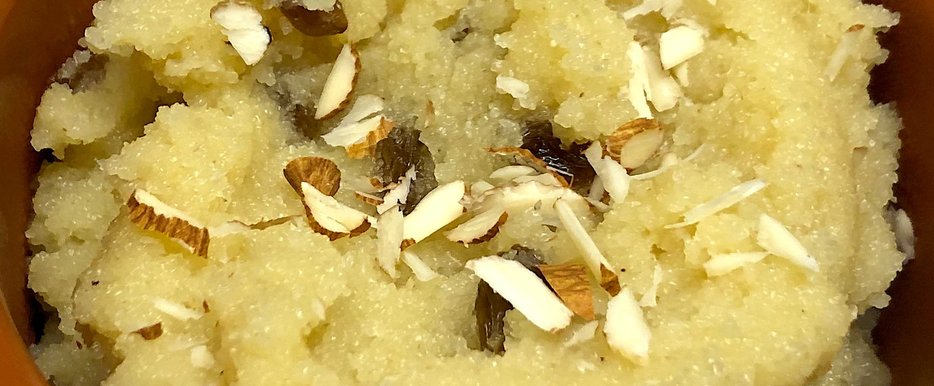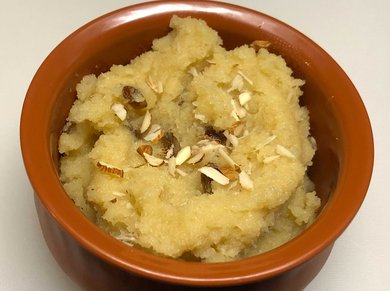Suji Halwa
Halwa is any of various dense, sweet confections with roots in West Asia (Levant) or the Indian subcontinent. It is also served in the Caucasus, North Africa, the Horn of Africa, the Balkans, Eastern and Western Europe, Malta and in the Jewish diaspora.
In some Indian cultures, the dish is known as a soup-based sweet. Identical sweets exist in other countries, such as China, though these are not generally referred to as "halva".
In global, popular usage it means "desserts" or "sweet", and describes two types of desserts:
Flour-based
This type of halva is slightly gelatinous and made from grain flour, typically semolina (suji- India). Its primary ingredients are clarified butter (ghee), flour, and sugar.
Nut butter-based
This type of halva is crumbly and usually made from tahini (sesame paste) or other nut butters, such as sunflower seed butter. Its primary ingredients are nut butter and sugar.
Halva may also be based on various other ingredients, including beans, lentils, and vegetables such as carrots, pumpkins, yams and squashes.
Halva can be kept at room temperature with little risk of spoilage. However, during hot summer months, it is better kept refrigerated, as it can turn runny after several days.
Suji Halwa also known as Semolina halwa or Rava halwa, is usually made with wheat semolina, sugar or honey, and ghee or butter or vegetable oil. Raisins, dates, other dried fruits, or nuts such as almonds or walnuts are often added to semolina halva.
The halva is very sweet, with a gelatinous texture similar to polenta; the added butter gives it a rich mouth feel.
The standard proportions of semolina halva are: one part fat (a vegetable oil or butter), two parts semolina, two parts sweetening agent (e.g. sugar or honey), and four parts water.
The semolina is sautéed in the fat, while a syrup is made from the sweetener and water. Then the two are mixed carefully while hot, and any extra ingredients are added. At this point, the halva is off-white to light beige, and rather soft. Depending on recipe and taste, it can be cooked a bit further, which makes it darker and firmer, or left to set as is.
It's easy to make and requires few ingredients. In some states of India it is served in breakfast or as an evening snacks.
 Recipe Servings: 2 - 3
Recipe Servings: 2 - 3
 Cooking time: 20 Minutes
Cooking time: 20 Minutes
Ingredients
- Suji (Rava/Semolina) - 1/2 cup
- Ghee (Clarified Butter) or Vegetable Oil- 1/4 cup
For Sugar Syrup
- Sugar - 1/3 cup
- Water - 1.5 cups
- Green Cardamom Powder (Choti Elaichi Powder/Hari Elaichi Powder) - 1/8 tsp
- Saffron Strings (Kaser) - few (optional)
- Raisins (Kishmish) - 1 tbsp
For Garnishing
- Pistachios (Sliced) - 1 tbsp
- Almonds (Sliced) - 1 tbsp
Preparation
- Melt ghee (clarified butter) or oil in a deep, heavy based sauce pan and then add suji into the melted/heated oil or ghee. Stir fry over a medium flame. Stir continuously so that suji (semolina/rava) won't burn. You can use the vegetable oil instead of ghee (clarified butter) to make it vegan.
- Roast it until suji turns into golden-brown. It will take about 8-10 minutes.
- At the same time, in another pan dissolve the sugar in 1.5 cups of water over a low flame. Also add ^the cardamom powder, saffron string (kesar) and raisins (kishmish) into it and keep on simmer, till required. It is optional to add saffron strings.
- Reduce the flame to low and add the sugar syrup slowly into the roasted suji (semolina/rava) and mix by stirring constantly (add water in small incremental quantities as it will splutter as soon as you add it to the suji (semolina/rava)).
- Stir continuously and cook to avoid any lump formation.
- Increase the flame to medium and cook until all water gets absorbed. It will take approximately 4-5 minutes.
- Suji Halwa (Semolina Halwa / Rava Halwa) is ready to serve.
- Garnish it with sliced almonds and pistachios and serve it hot.
- Enjoy hot suji halwa with your loved ones.



